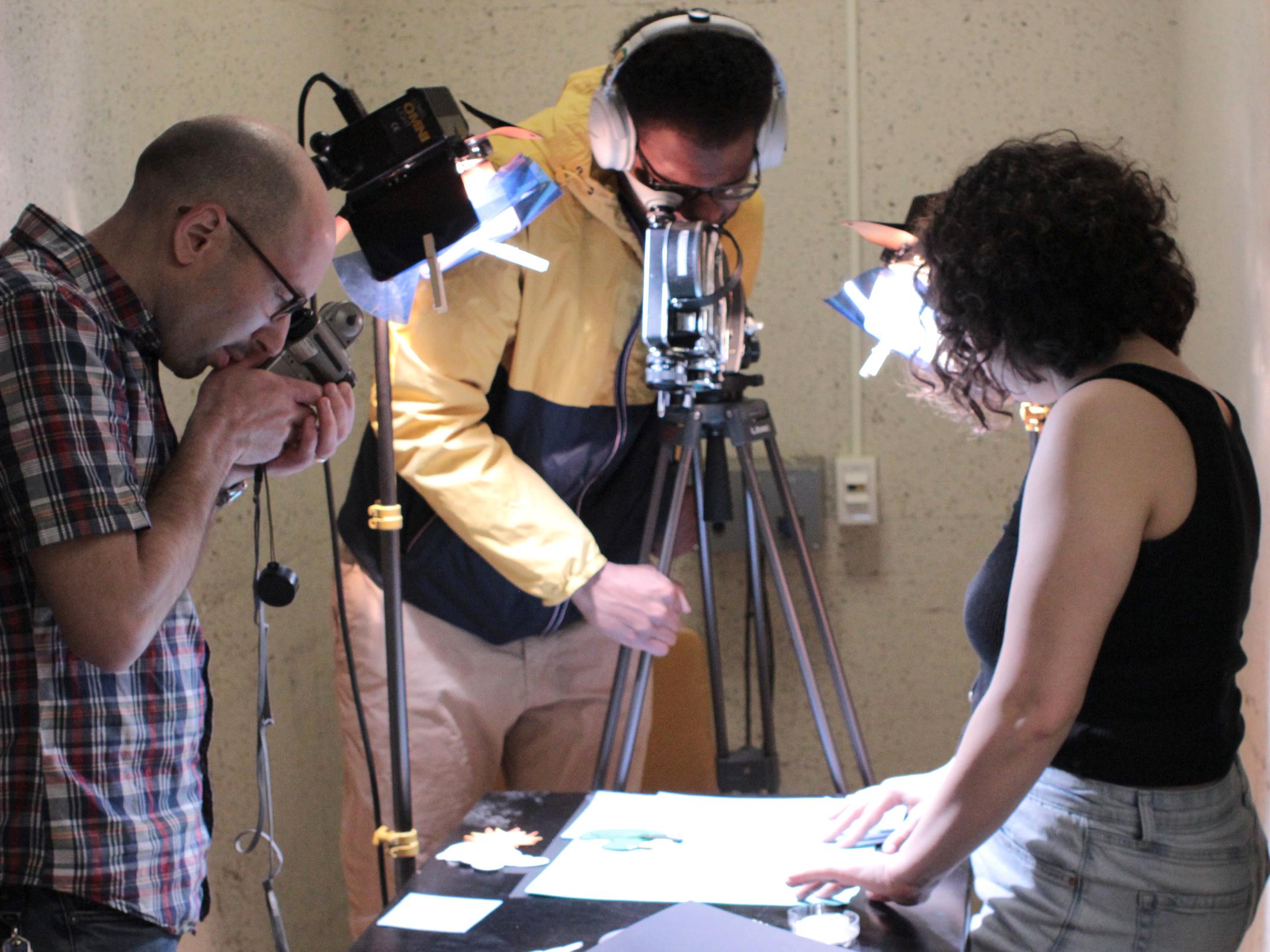SUNY Oswego faculty and students work on a stop-motion animation project as part of producing three short films on local landmark Fort Ontario. From left are cinema and screen studies faculty member Jacob Dodd with students Jensen Fresnel and Raizel Demaria. (Photo by Shayla Rios.)
On Tuesday Dec. 3, SUNY Oswego’s Cinema and Screen Studies Department will host a screening of their finished 16 mm short films on local historic treasure Fort Ontario in the Marano Campus Center auditorium (room 132).
The three short films will each run between 15 to 20 minutes and allow for the audience to interact with a Q and A afterward. The event will take place from 4 p.m. to 6 p.m.
The films are the work of students in courses taught by Jacob Dodd, an associate professor of cinema and screen studies. Titled “History of Fort Ontario,” “Touring the Grounds” and “A History of Food at Fort Ontario,” all three short films also cater to different audiences of several ages and interests.
The process of creating these projects started after Dodd applied for the Shineman Endowed Fund in fall 2022. The grant, which gave $10,059 to the department, allowed them to create their Media Archeology Laboratory.
The laboratory allowed students to access more legacy equipment such as 16 mm and Super 8 mm cameras, film projectors and film editing tables. Other costs such as film stock also are covered by the grant, allowing for the 30 rolls of film for these projects to be shot, developed, transferred digitally and sound-edited.
The Shineman Endowed Fund grant also allowed the department to build its collection of equipment in other ways, such as receiving more transferred equipment from outside campus. Equipment has been collected from other institutions such as SUNY Purchase and SUNY Upstate Medical University to add to their lab.
The lab will also expand to students and faculty beyond just in-department use. Once Hewitt Hall re-opens in fall 2025 following extensive renovations, it will allow more accessibility to ab resources for students or anyone who wants to engage with the equipment.
The grant was received in January 2023, and shooting for the films began in February and March of that same year. The first film put into production was “History of Fort Ontario.”
Variety of films
“History of Fort Ontario” aims more for an audience of children and covers the timeline of Fort Ontario from 1755 to the present day. It will also include paper-animated shadow puppets and both a child and adult narrator.
“Touring the Grounds,” the second short film appeals more to individuals who want to see the exhibition space of Fort Ontario, but might be unable to physically do so. It provides a detailed walk-through tour, with a narration playing to give contexts. The film also includes musical selections from the time period created by Oswego composer Larry Rapshaw.
“A History of Food at Fort Ontario” features a series of actors playing previous inhabitants discussing what they ate and how they lived during the time period. These will include soldiers and Holocaust refugees who lived there when the fort hosted an only-of-its-kind refugee shelter during World War II for nearly 1,000 people fleeing Europe.
Campus-community connection
These projects were also special to Dodd and the students because of the close work they had with Paul Lear and the rest of the staff at Fort Ontario.
Lear, the now-retired site manager for Fort Ontario, helped greatly by writing the scripts for “Touring the Grounds” and “A History of Food at Fort Ontario.” He also participated as the on-camera interviewer for the third film.
The fort staff helped in reenacting scenes, setting up and allowing access for spaces to shoot the films t at different parts of the day. They even helped with the preparation and accuracy of the food for “A History of Food at Fort Ontario.”
With the screenings approaching, Dodd looks forward to the hard work of his students and the Fort Ontario staff to be recognized. He also cannot wait for their work to continue the legacy the department has brought to SUNY Oswego and the local community.
“We have a culture that Oswego brings that makes our art make a difference,” said Dodd. “It’s not just a classroom project, it’s a project with more life and meaning.”
The Fort Ontario 16 mm Film Screening will be free and open to the public. Any children under the age of 17 must be accompanied by an adult for the duration of the program.
–- Written by Leila LaJoie of the Class of 2024




